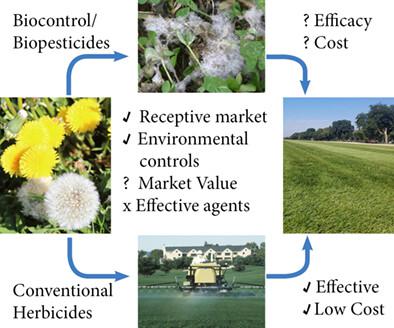当前位置:
X-MOL 学术
›
Pest Manag. Sci.
›
论文详情
Our official English website, www.x-mol.net, welcomes your feedback! (Note: you will need to create a separate account there.)
Biological Control of Weeds in turfgrass: opportunities and misconceptions
Pest Management Science ( IF 4.1 ) Pub Date : 2023-03-02 , DOI: 10.1002/ps.7436 Joseph C Neal 1
Pest Management Science ( IF 4.1 ) Pub Date : 2023-03-02 , DOI: 10.1002/ps.7436 Joseph C Neal 1
Affiliation

|
Turfgrass systems may offer opportunities for overcoming some constraints on the successful implementation of weed biocontrol. Of the roughly 16.4 million ha of turfgrass in the USA, ≈60–75% are in residential lawns and 3% are golf turf. Annual expenditures for a standard herbicide treatment regimen for residential turf are estimated to be ≈US$326 ha−1, about 2–3-fold greater than that for USA corn and soybean growers. Expenditures can be >US$3000 ha−1 for control of certain weeds such as Poa annua in high-value areas including golf fairways or greens, but those applications are made to far smaller areas. Regulatory actions and consumer preferences are creating market opportunities for alternatives to synthetic herbicides in both commercial and consumer markets, but the size of these markets and willingness-to-pay are poorly documented. Turfgrass sites are intensively managed, yet despite the ability to modify site conditions through irrigation, mowing and fertility management, microbial biocontrol agents tested thus far have not provided the consistently high levels of weed control expected in the market. Recent advances in microbial bioherbicide products may offer a path to overcome many of the obstacles to success. No single herbicide will control the diversity of turfgrass weeds, nor will any single biocontrol agent or biopesticide. Successful development of weed biocontrol for turfgrass systems will require numerous, effective biocontrol agents for the many weed species found in turfgrass environments, as well as a deeper understanding of different turfgrass market segments, and weed management expectations for each segment. © 2023 The Author. Pest Management Science published by John Wiley & Sons Ltd on behalf of Society of Chemical Industry.
中文翻译:

草坪杂草的生物防治:机遇和误解
草坪系统可能为克服杂草生物防治成功实施的一些限制提供机会。在美国约 1640 万公顷的草坪中,约 60-75% 为住宅草坪,3% 为高尔夫球场草坪。住宅草坪标准除草剂处理方案的年度支出估计约为 326 ha -1美元,比美国玉米和大豆种植者的支出高出约 2-3 倍。用于控制某些杂草(例如高尔夫球道或果岭等高价值地区的早熟禾)的支出可能>3000 ha -1,但这些应用仅适用于小得多的地区。监管行动和消费者偏好正在为商业和消费市场上的合成除草剂替代品创造市场机会,但这些市场的规模和支付意愿却鲜有记录。草坪场地受到集中管理,尽管能够通过灌溉、割草和肥力管理来改变场地条件,但迄今为止测试的微生物生物防治剂尚未提供市场预期的持续高水平的杂草控制。微生物除草剂产品的最新进展可能提供克服许多成功障碍的途径。没有任何一种除草剂能够控制草坪杂草的多样性,任何一种生物防治剂或生物农药也不能控制草坪杂草的多样性。草坪草生物防治系统的成功开发将需要针对草坪环境中发现的多种杂草物种的大量有效的生物防治剂,以及对不同草坪细分市场和每个细分市场的杂草管理期望的更深入的了解。© 2023 作者。《害虫管理科学》由 John Wiley & Sons Ltd 代表化学工业协会出版。
更新日期:2023-03-02
中文翻译:

草坪杂草的生物防治:机遇和误解
草坪系统可能为克服杂草生物防治成功实施的一些限制提供机会。在美国约 1640 万公顷的草坪中,约 60-75% 为住宅草坪,3% 为高尔夫球场草坪。住宅草坪标准除草剂处理方案的年度支出估计约为 326 ha -1美元,比美国玉米和大豆种植者的支出高出约 2-3 倍。用于控制某些杂草(例如高尔夫球道或果岭等高价值地区的早熟禾)的支出可能>3000 ha -1,但这些应用仅适用于小得多的地区。监管行动和消费者偏好正在为商业和消费市场上的合成除草剂替代品创造市场机会,但这些市场的规模和支付意愿却鲜有记录。草坪场地受到集中管理,尽管能够通过灌溉、割草和肥力管理来改变场地条件,但迄今为止测试的微生物生物防治剂尚未提供市场预期的持续高水平的杂草控制。微生物除草剂产品的最新进展可能提供克服许多成功障碍的途径。没有任何一种除草剂能够控制草坪杂草的多样性,任何一种生物防治剂或生物农药也不能控制草坪杂草的多样性。草坪草生物防治系统的成功开发将需要针对草坪环境中发现的多种杂草物种的大量有效的生物防治剂,以及对不同草坪细分市场和每个细分市场的杂草管理期望的更深入的了解。© 2023 作者。《害虫管理科学》由 John Wiley & Sons Ltd 代表化学工业协会出版。


























 京公网安备 11010802027423号
京公网安备 11010802027423号